Research Report: Nokia's Strategies for Entering Emerging Markets
VerifiedAdded on 2021/02/19
|32
|7938
|26
Report
AI Summary
This research report investigates the strategies employed by businesses, specifically focusing on Nokia, to enter emerging markets. The report begins with an introduction outlining the background of globalization and its impact on business expansion, followed by the aims and objectives of the study, including understanding current globalization trends, assessing different entry strategies, identifying challenges, and recommending suitable approaches. A comprehensive literature review explores themes such as globalization trends, various entry strategies (exporting, licensing, joint ventures, franchising, and partnering), and challenges faced by companies. The methodology section details the research philosophy (Interpretivism), approach (inductive), design (exploratory), sampling method (probability), data collection methods (primary and secondary), and data analysis techniques (qualitative). Ethical considerations and a timeline of research activities are also included. The report concludes with a discussion of findings, conclusions, and recommendations for businesses seeking to enter emerging markets, along with a reflection on the research process. The research provides valuable insights into the complexities of international business expansion.
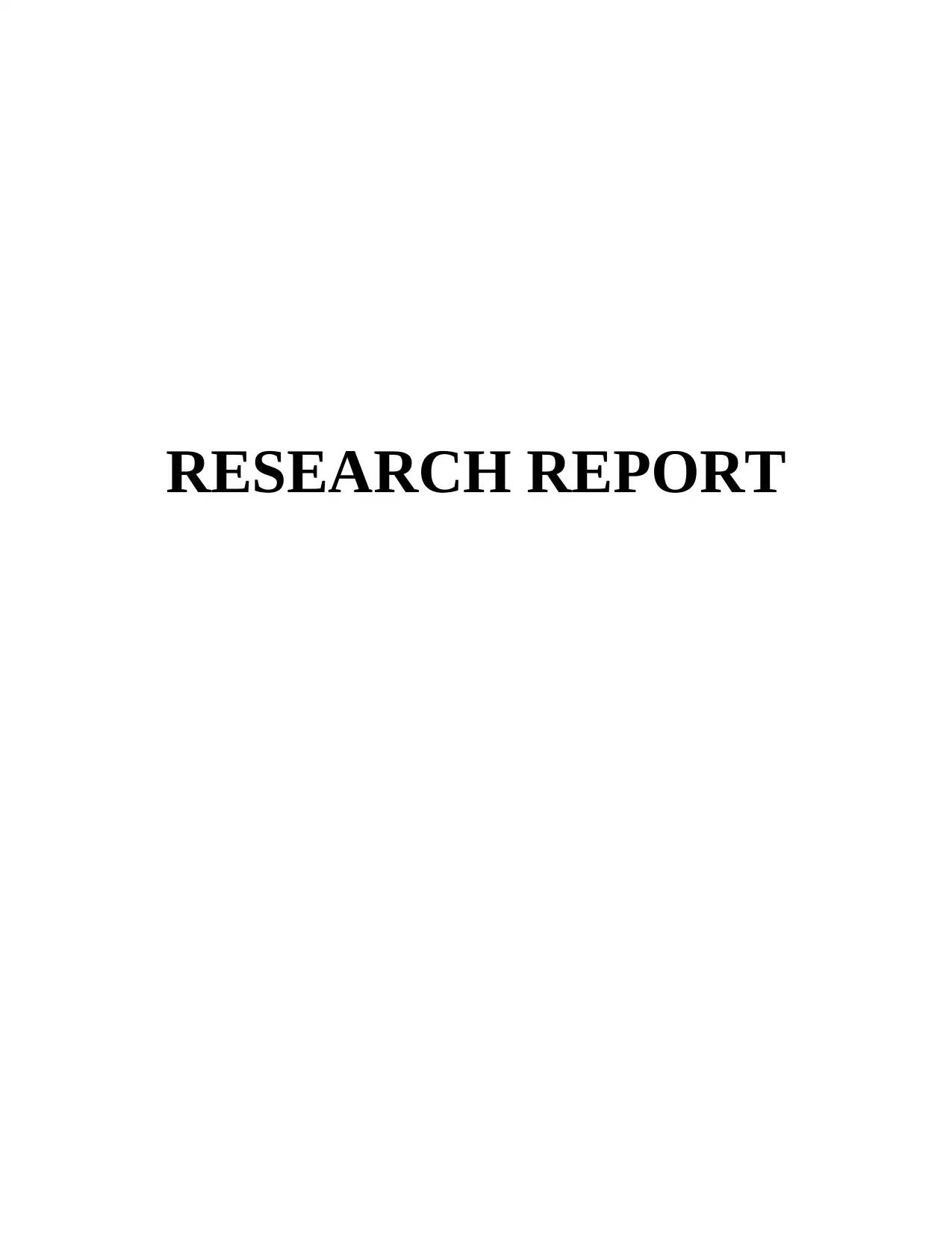
RESEARCH REPORT
Paraphrase This Document
Need a fresh take? Get an instant paraphrase of this document with our AI Paraphraser
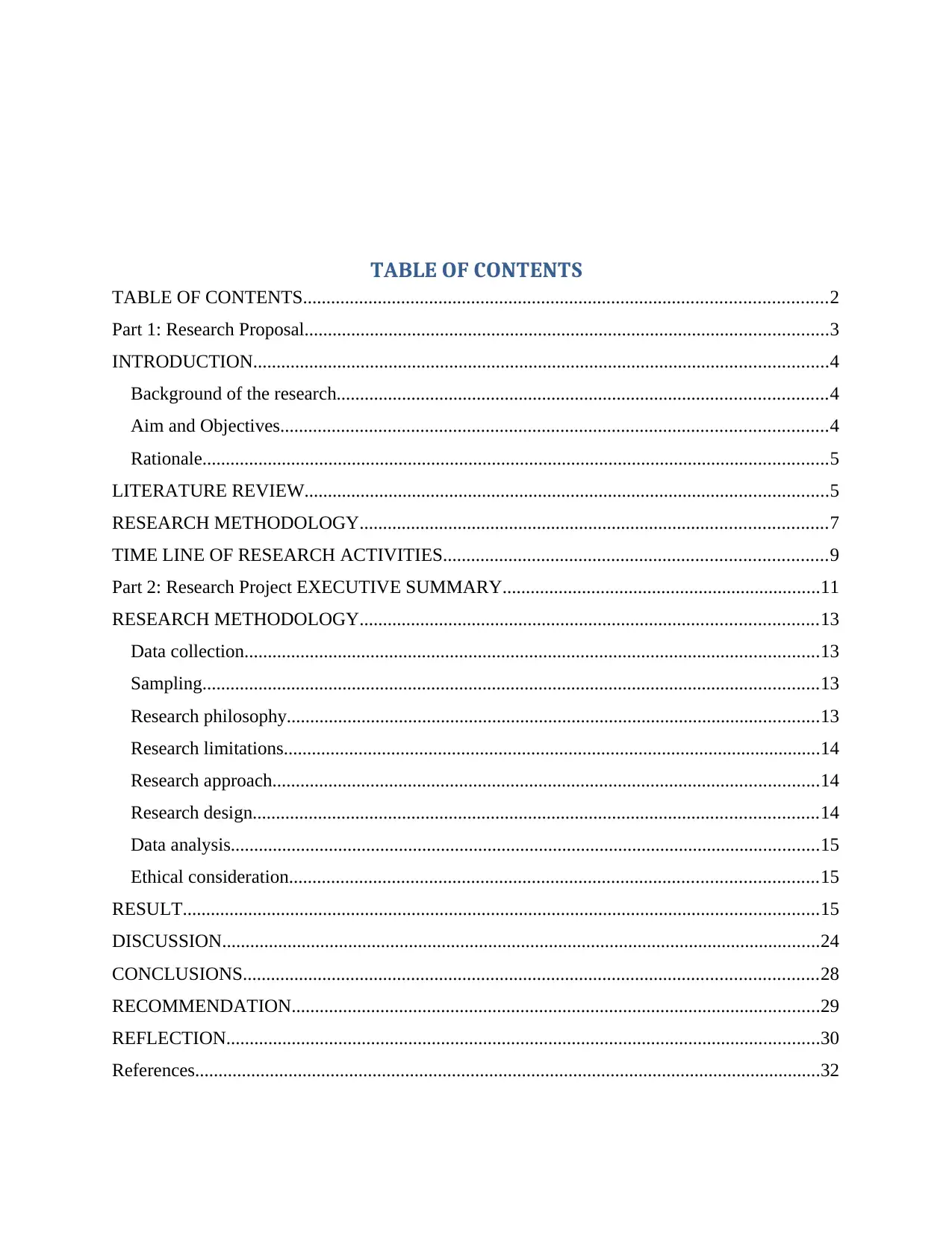
TABLE OF CONTENTS
TABLE OF CONTENTS................................................................................................................2
Part 1: Research Proposal................................................................................................................3
INTRODUCTION...........................................................................................................................4
Background of the research.........................................................................................................4
Aim and Objectives.....................................................................................................................4
Rationale......................................................................................................................................5
LITERATURE REVIEW................................................................................................................5
RESEARCH METHODOLOGY....................................................................................................7
TIME LINE OF RESEARCH ACTIVITIES..................................................................................9
Part 2: Research Project EXECUTIVE SUMMARY....................................................................11
RESEARCH METHODOLOGY..................................................................................................13
Data collection...........................................................................................................................13
Sampling....................................................................................................................................13
Research philosophy..................................................................................................................13
Research limitations...................................................................................................................14
Research approach.....................................................................................................................14
Research design.........................................................................................................................14
Data analysis..............................................................................................................................15
Ethical consideration.................................................................................................................15
RESULT........................................................................................................................................15
DISCUSSION................................................................................................................................24
CONCLUSIONS...........................................................................................................................28
RECOMMENDATION.................................................................................................................29
REFLECTION...............................................................................................................................30
References......................................................................................................................................32
TABLE OF CONTENTS................................................................................................................2
Part 1: Research Proposal................................................................................................................3
INTRODUCTION...........................................................................................................................4
Background of the research.........................................................................................................4
Aim and Objectives.....................................................................................................................4
Rationale......................................................................................................................................5
LITERATURE REVIEW................................................................................................................5
RESEARCH METHODOLOGY....................................................................................................7
TIME LINE OF RESEARCH ACTIVITIES..................................................................................9
Part 2: Research Project EXECUTIVE SUMMARY....................................................................11
RESEARCH METHODOLOGY..................................................................................................13
Data collection...........................................................................................................................13
Sampling....................................................................................................................................13
Research philosophy..................................................................................................................13
Research limitations...................................................................................................................14
Research approach.....................................................................................................................14
Research design.........................................................................................................................14
Data analysis..............................................................................................................................15
Ethical consideration.................................................................................................................15
RESULT........................................................................................................................................15
DISCUSSION................................................................................................................................24
CONCLUSIONS...........................................................................................................................28
RECOMMENDATION.................................................................................................................29
REFLECTION...............................................................................................................................30
References......................................................................................................................................32

⊘ This is a preview!⊘
Do you want full access?
Subscribe today to unlock all pages.

Trusted by 1+ million students worldwide

Part 1: Research Proposal
Paraphrase This Document
Need a fresh take? Get an instant paraphrase of this document with our AI Paraphraser
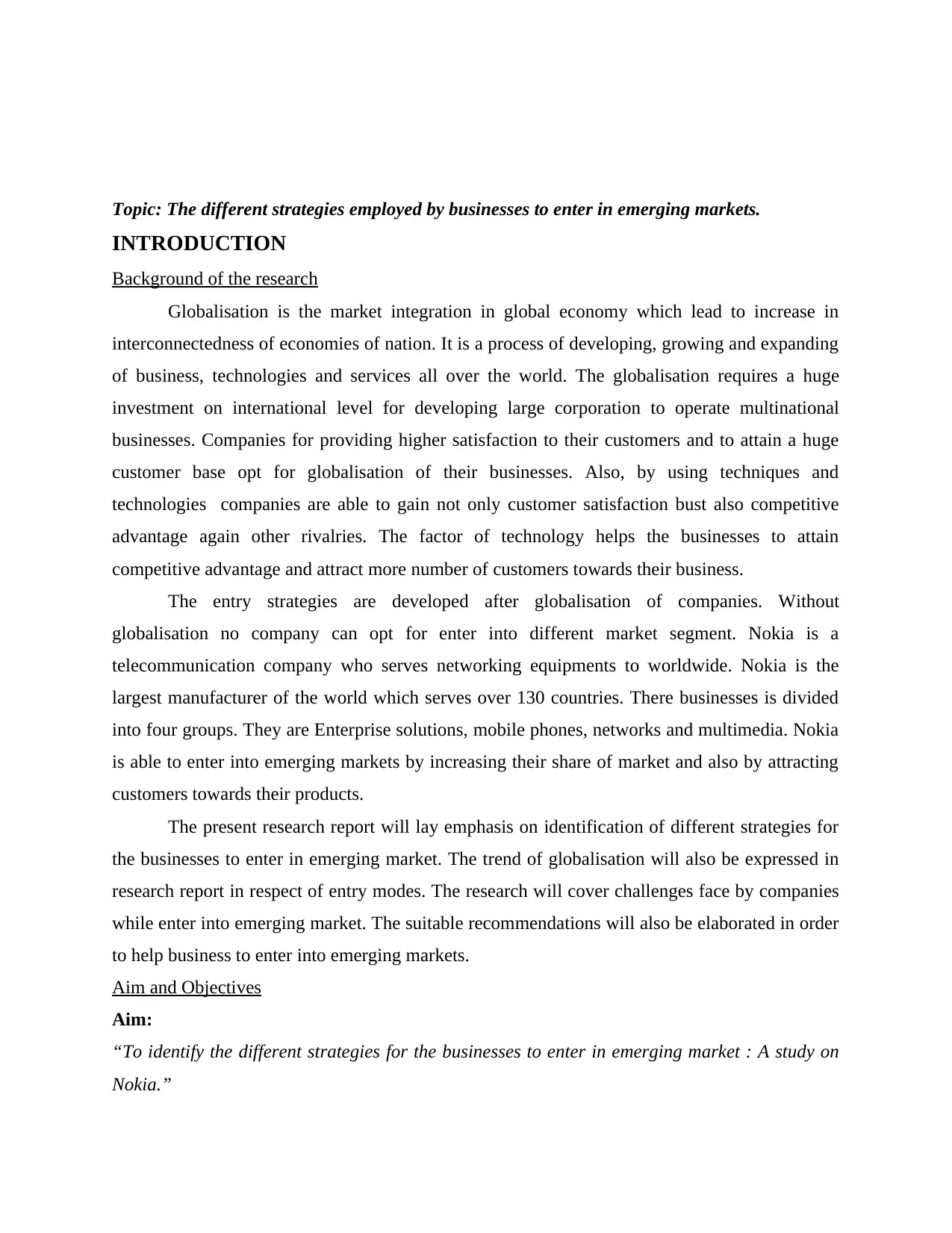
Topic: The different strategies employed by businesses to enter in emerging markets.
INTRODUCTION
Background of the research
Globalisation is the market integration in global economy which lead to increase in
interconnectedness of economies of nation. It is a process of developing, growing and expanding
of business, technologies and services all over the world. The globalisation requires a huge
investment on international level for developing large corporation to operate multinational
businesses. Companies for providing higher satisfaction to their customers and to attain a huge
customer base opt for globalisation of their businesses. Also, by using techniques and
technologies companies are able to gain not only customer satisfaction bust also competitive
advantage again other rivalries. The factor of technology helps the businesses to attain
competitive advantage and attract more number of customers towards their business.
The entry strategies are developed after globalisation of companies. Without
globalisation no company can opt for enter into different market segment. Nokia is a
telecommunication company who serves networking equipments to worldwide. Nokia is the
largest manufacturer of the world which serves over 130 countries. There businesses is divided
into four groups. They are Enterprise solutions, mobile phones, networks and multimedia. Nokia
is able to enter into emerging markets by increasing their share of market and also by attracting
customers towards their products.
The present research report will lay emphasis on identification of different strategies for
the businesses to enter in emerging market. The trend of globalisation will also be expressed in
research report in respect of entry modes. The research will cover challenges face by companies
while enter into emerging market. The suitable recommendations will also be elaborated in order
to help business to enter into emerging markets.
Aim and Objectives
Aim:
“To identify the different strategies for the businesses to enter in emerging market : A study on
Nokia.”
INTRODUCTION
Background of the research
Globalisation is the market integration in global economy which lead to increase in
interconnectedness of economies of nation. It is a process of developing, growing and expanding
of business, technologies and services all over the world. The globalisation requires a huge
investment on international level for developing large corporation to operate multinational
businesses. Companies for providing higher satisfaction to their customers and to attain a huge
customer base opt for globalisation of their businesses. Also, by using techniques and
technologies companies are able to gain not only customer satisfaction bust also competitive
advantage again other rivalries. The factor of technology helps the businesses to attain
competitive advantage and attract more number of customers towards their business.
The entry strategies are developed after globalisation of companies. Without
globalisation no company can opt for enter into different market segment. Nokia is a
telecommunication company who serves networking equipments to worldwide. Nokia is the
largest manufacturer of the world which serves over 130 countries. There businesses is divided
into four groups. They are Enterprise solutions, mobile phones, networks and multimedia. Nokia
is able to enter into emerging markets by increasing their share of market and also by attracting
customers towards their products.
The present research report will lay emphasis on identification of different strategies for
the businesses to enter in emerging market. The trend of globalisation will also be expressed in
research report in respect of entry modes. The research will cover challenges face by companies
while enter into emerging market. The suitable recommendations will also be elaborated in order
to help business to enter into emerging markets.
Aim and Objectives
Aim:
“To identify the different strategies for the businesses to enter in emerging market : A study on
Nokia.”
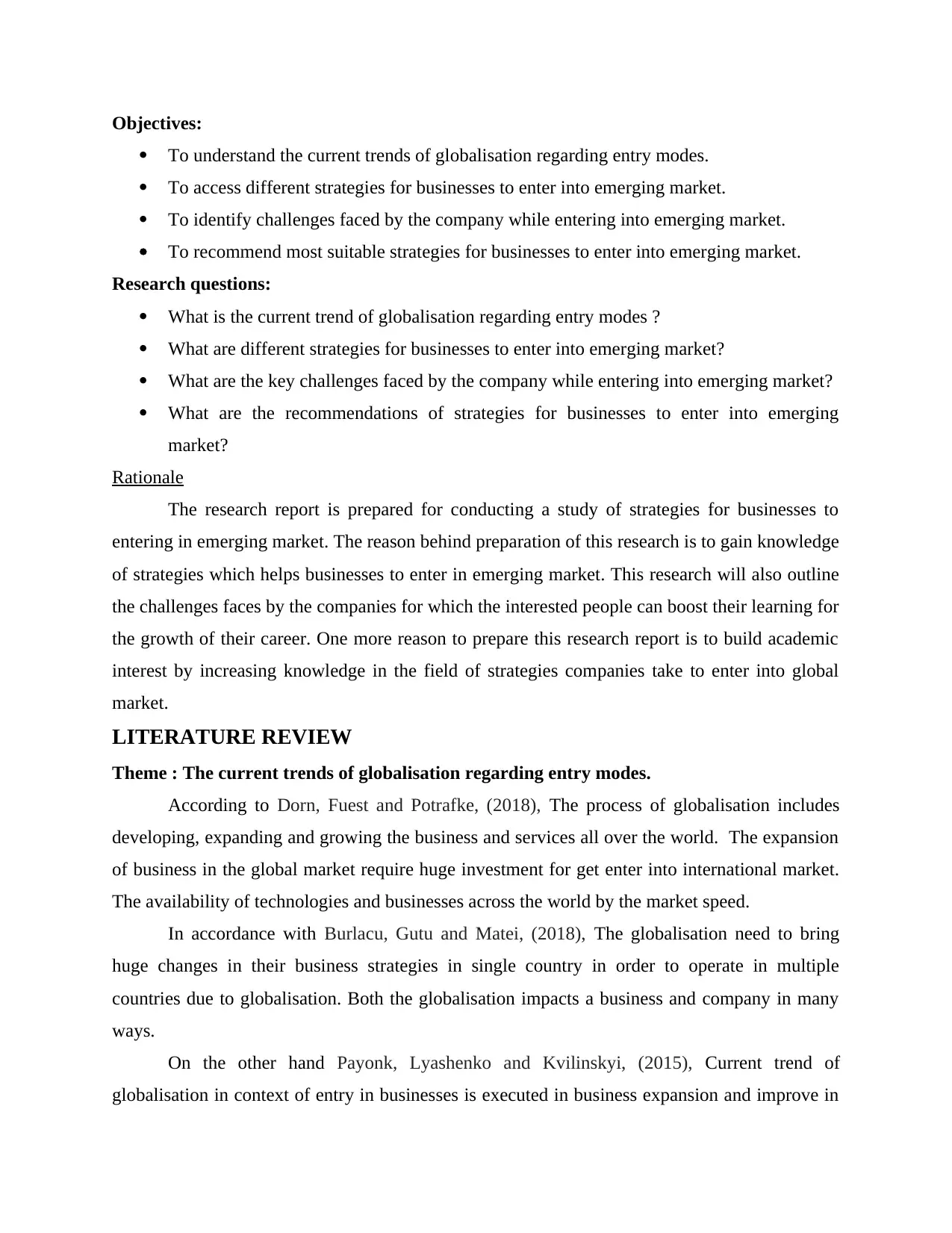
Objectives:
To understand the current trends of globalisation regarding entry modes.
To access different strategies for businesses to enter into emerging market.
To identify challenges faced by the company while entering into emerging market.
To recommend most suitable strategies for businesses to enter into emerging market.
Research questions:
What is the current trend of globalisation regarding entry modes ?
What are different strategies for businesses to enter into emerging market?
What are the key challenges faced by the company while entering into emerging market?
What are the recommendations of strategies for businesses to enter into emerging
market?
Rationale
The research report is prepared for conducting a study of strategies for businesses to
entering in emerging market. The reason behind preparation of this research is to gain knowledge
of strategies which helps businesses to enter in emerging market. This research will also outline
the challenges faces by the companies for which the interested people can boost their learning for
the growth of their career. One more reason to prepare this research report is to build academic
interest by increasing knowledge in the field of strategies companies take to enter into global
market.
LITERATURE REVIEW
Theme : The current trends of globalisation regarding entry modes.
According to Dorn, Fuest and Potrafke, (2018), The process of globalisation includes
developing, expanding and growing the business and services all over the world. The expansion
of business in the global market require huge investment for get enter into international market.
The availability of technologies and businesses across the world by the market speed.
In accordance with Burlacu, Gutu and Matei, (2018), The globalisation need to bring
huge changes in their business strategies in single country in order to operate in multiple
countries due to globalisation. Both the globalisation impacts a business and company in many
ways.
On the other hand Payonk, Lyashenko and Kvilinskyi, (2015), Current trend of
globalisation in context of entry in businesses is executed in business expansion and improve in
To understand the current trends of globalisation regarding entry modes.
To access different strategies for businesses to enter into emerging market.
To identify challenges faced by the company while entering into emerging market.
To recommend most suitable strategies for businesses to enter into emerging market.
Research questions:
What is the current trend of globalisation regarding entry modes ?
What are different strategies for businesses to enter into emerging market?
What are the key challenges faced by the company while entering into emerging market?
What are the recommendations of strategies for businesses to enter into emerging
market?
Rationale
The research report is prepared for conducting a study of strategies for businesses to
entering in emerging market. The reason behind preparation of this research is to gain knowledge
of strategies which helps businesses to enter in emerging market. This research will also outline
the challenges faces by the companies for which the interested people can boost their learning for
the growth of their career. One more reason to prepare this research report is to build academic
interest by increasing knowledge in the field of strategies companies take to enter into global
market.
LITERATURE REVIEW
Theme : The current trends of globalisation regarding entry modes.
According to Dorn, Fuest and Potrafke, (2018), The process of globalisation includes
developing, expanding and growing the business and services all over the world. The expansion
of business in the global market require huge investment for get enter into international market.
The availability of technologies and businesses across the world by the market speed.
In accordance with Burlacu, Gutu and Matei, (2018), The globalisation need to bring
huge changes in their business strategies in single country in order to operate in multiple
countries due to globalisation. Both the globalisation impacts a business and company in many
ways.
On the other hand Payonk, Lyashenko and Kvilinskyi, (2015), Current trend of
globalisation in context of entry in businesses is executed in business expansion and improve in
⊘ This is a preview!⊘
Do you want full access?
Subscribe today to unlock all pages.

Trusted by 1+ million students worldwide
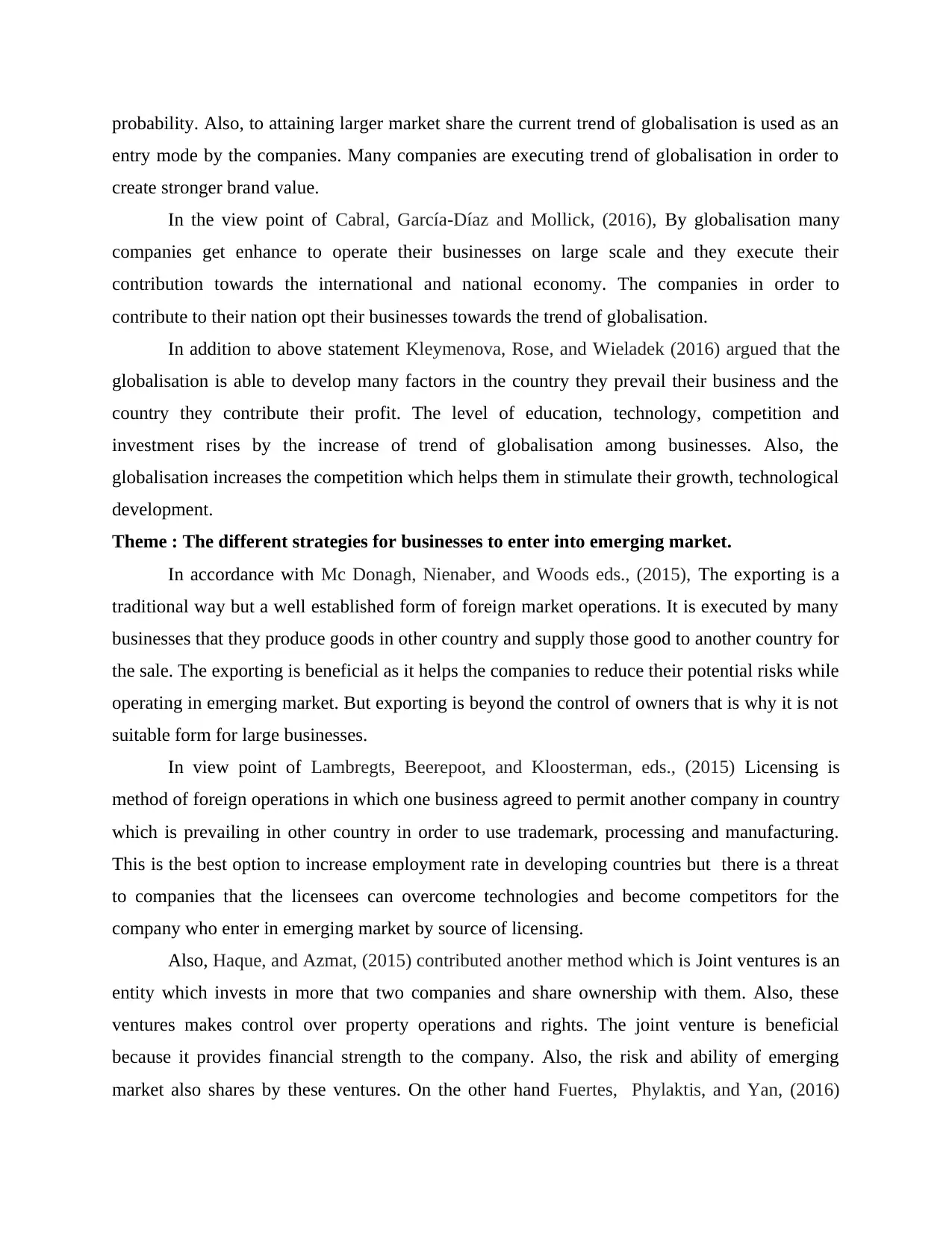
probability. Also, to attaining larger market share the current trend of globalisation is used as an
entry mode by the companies. Many companies are executing trend of globalisation in order to
create stronger brand value.
In the view point of Cabral, García-Díaz and Mollick, (2016), By globalisation many
companies get enhance to operate their businesses on large scale and they execute their
contribution towards the international and national economy. The companies in order to
contribute to their nation opt their businesses towards the trend of globalisation.
In addition to above statement Kleymenova, Rose, and Wieladek (2016) argued that the
globalisation is able to develop many factors in the country they prevail their business and the
country they contribute their profit. The level of education, technology, competition and
investment rises by the increase of trend of globalisation among businesses. Also, the
globalisation increases the competition which helps them in stimulate their growth, technological
development.
Theme : The different strategies for businesses to enter into emerging market.
In accordance with Mc Donagh, Nienaber, and Woods eds., (2015), The exporting is a
traditional way but a well established form of foreign market operations. It is executed by many
businesses that they produce goods in other country and supply those good to another country for
the sale. The exporting is beneficial as it helps the companies to reduce their potential risks while
operating in emerging market. But exporting is beyond the control of owners that is why it is not
suitable form for large businesses.
In view point of Lambregts, Beerepoot, and Kloosterman, eds., (2015) Licensing is
method of foreign operations in which one business agreed to permit another company in country
which is prevailing in other country in order to use trademark, processing and manufacturing.
This is the best option to increase employment rate in developing countries but there is a threat
to companies that the licensees can overcome technologies and become competitors for the
company who enter in emerging market by source of licensing.
Also, Haque, and Azmat, (2015) contributed another method which is Joint ventures is an
entity which invests in more that two companies and share ownership with them. Also, these
ventures makes control over property operations and rights. The joint venture is beneficial
because it provides financial strength to the company. Also, the risk and ability of emerging
market also shares by these ventures. On the other hand Fuertes, Phylaktis, and Yan, (2016)
entry mode by the companies. Many companies are executing trend of globalisation in order to
create stronger brand value.
In the view point of Cabral, García-Díaz and Mollick, (2016), By globalisation many
companies get enhance to operate their businesses on large scale and they execute their
contribution towards the international and national economy. The companies in order to
contribute to their nation opt their businesses towards the trend of globalisation.
In addition to above statement Kleymenova, Rose, and Wieladek (2016) argued that the
globalisation is able to develop many factors in the country they prevail their business and the
country they contribute their profit. The level of education, technology, competition and
investment rises by the increase of trend of globalisation among businesses. Also, the
globalisation increases the competition which helps them in stimulate their growth, technological
development.
Theme : The different strategies for businesses to enter into emerging market.
In accordance with Mc Donagh, Nienaber, and Woods eds., (2015), The exporting is a
traditional way but a well established form of foreign market operations. It is executed by many
businesses that they produce goods in other country and supply those good to another country for
the sale. The exporting is beneficial as it helps the companies to reduce their potential risks while
operating in emerging market. But exporting is beyond the control of owners that is why it is not
suitable form for large businesses.
In view point of Lambregts, Beerepoot, and Kloosterman, eds., (2015) Licensing is
method of foreign operations in which one business agreed to permit another company in country
which is prevailing in other country in order to use trademark, processing and manufacturing.
This is the best option to increase employment rate in developing countries but there is a threat
to companies that the licensees can overcome technologies and become competitors for the
company who enter in emerging market by source of licensing.
Also, Haque, and Azmat, (2015) contributed another method which is Joint ventures is an
entity which invests in more that two companies and share ownership with them. Also, these
ventures makes control over property operations and rights. The joint venture is beneficial
because it provides financial strength to the company. Also, the risk and ability of emerging
market also shares by these ventures. On the other hand Fuertes, Phylaktis, and Yan, (2016)
Paraphrase This Document
Need a fresh take? Get an instant paraphrase of this document with our AI Paraphraser
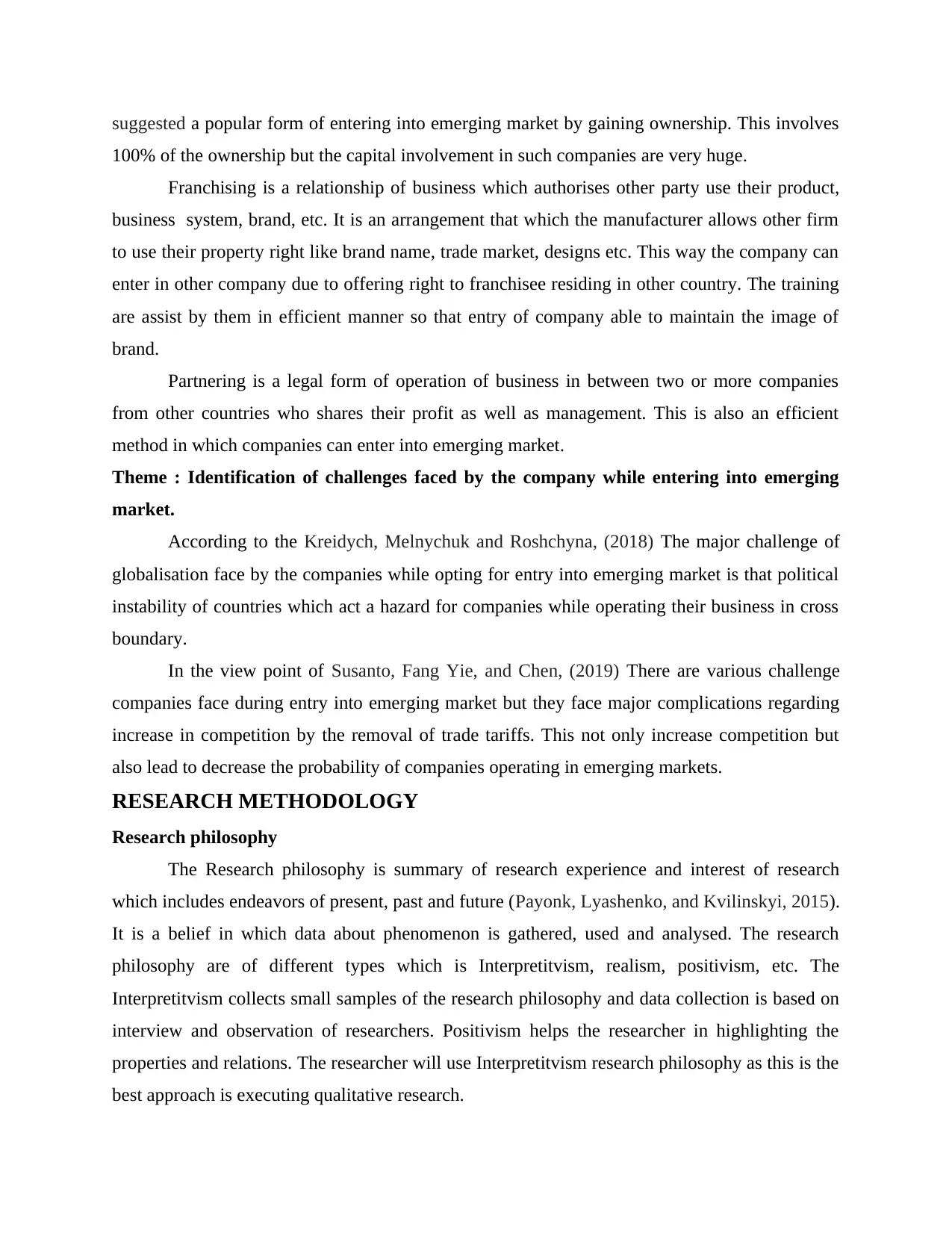
suggested a popular form of entering into emerging market by gaining ownership. This involves
100% of the ownership but the capital involvement in such companies are very huge.
Franchising is a relationship of business which authorises other party use their product,
business system, brand, etc. It is an arrangement that which the manufacturer allows other firm
to use their property right like brand name, trade market, designs etc. This way the company can
enter in other company due to offering right to franchisee residing in other country. The training
are assist by them in efficient manner so that entry of company able to maintain the image of
brand.
Partnering is a legal form of operation of business in between two or more companies
from other countries who shares their profit as well as management. This is also an efficient
method in which companies can enter into emerging market.
Theme : Identification of challenges faced by the company while entering into emerging
market.
According to the Kreidych, Melnychuk and Roshchyna, (2018) The major challenge of
globalisation face by the companies while opting for entry into emerging market is that political
instability of countries which act a hazard for companies while operating their business in cross
boundary.
In the view point of Susanto, Fang Yie, and Chen, (2019) There are various challenge
companies face during entry into emerging market but they face major complications regarding
increase in competition by the removal of trade tariffs. This not only increase competition but
also lead to decrease the probability of companies operating in emerging markets.
RESEARCH METHODOLOGY
Research philosophy
The Research philosophy is summary of research experience and interest of research
which includes endeavors of present, past and future (Payonk, Lyashenko, and Kvilinskyi, 2015).
It is a belief in which data about phenomenon is gathered, used and analysed. The research
philosophy are of different types which is Interpretitvism, realism, positivism, etc. The
Interpretitvism collects small samples of the research philosophy and data collection is based on
interview and observation of researchers. Positivism helps the researcher in highlighting the
properties and relations. The researcher will use Interpretitvism research philosophy as this is the
best approach is executing qualitative research.
100% of the ownership but the capital involvement in such companies are very huge.
Franchising is a relationship of business which authorises other party use their product,
business system, brand, etc. It is an arrangement that which the manufacturer allows other firm
to use their property right like brand name, trade market, designs etc. This way the company can
enter in other company due to offering right to franchisee residing in other country. The training
are assist by them in efficient manner so that entry of company able to maintain the image of
brand.
Partnering is a legal form of operation of business in between two or more companies
from other countries who shares their profit as well as management. This is also an efficient
method in which companies can enter into emerging market.
Theme : Identification of challenges faced by the company while entering into emerging
market.
According to the Kreidych, Melnychuk and Roshchyna, (2018) The major challenge of
globalisation face by the companies while opting for entry into emerging market is that political
instability of countries which act a hazard for companies while operating their business in cross
boundary.
In the view point of Susanto, Fang Yie, and Chen, (2019) There are various challenge
companies face during entry into emerging market but they face major complications regarding
increase in competition by the removal of trade tariffs. This not only increase competition but
also lead to decrease the probability of companies operating in emerging markets.
RESEARCH METHODOLOGY
Research philosophy
The Research philosophy is summary of research experience and interest of research
which includes endeavors of present, past and future (Payonk, Lyashenko, and Kvilinskyi, 2015).
It is a belief in which data about phenomenon is gathered, used and analysed. The research
philosophy are of different types which is Interpretitvism, realism, positivism, etc. The
Interpretitvism collects small samples of the research philosophy and data collection is based on
interview and observation of researchers. Positivism helps the researcher in highlighting the
properties and relations. The researcher will use Interpretitvism research philosophy as this is the
best approach is executing qualitative research.
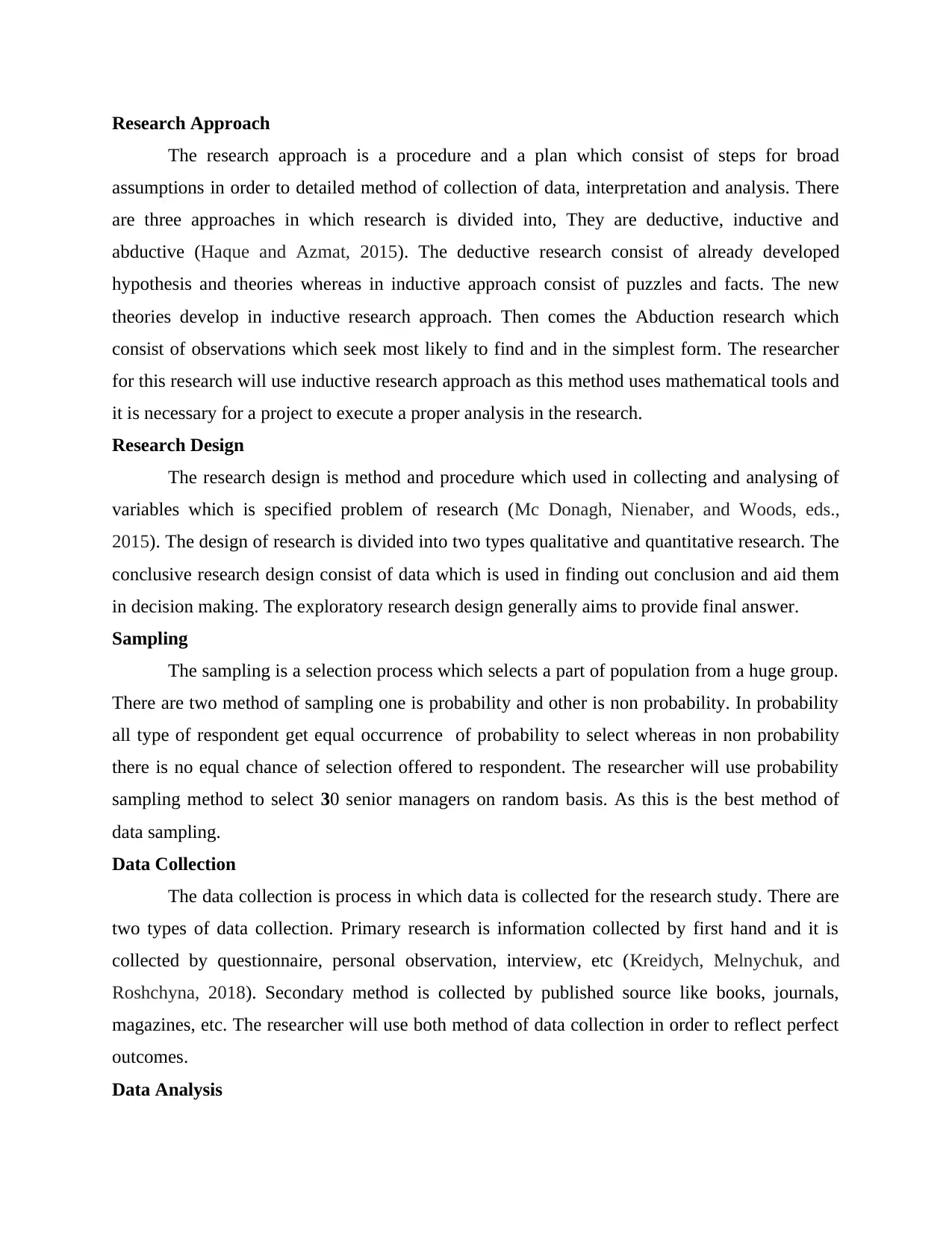
Research Approach
The research approach is a procedure and a plan which consist of steps for broad
assumptions in order to detailed method of collection of data, interpretation and analysis. There
are three approaches in which research is divided into, They are deductive, inductive and
abductive (Haque and Azmat, 2015). The deductive research consist of already developed
hypothesis and theories whereas in inductive approach consist of puzzles and facts. The new
theories develop in inductive research approach. Then comes the Abduction research which
consist of observations which seek most likely to find and in the simplest form. The researcher
for this research will use inductive research approach as this method uses mathematical tools and
it is necessary for a project to execute a proper analysis in the research.
Research Design
The research design is method and procedure which used in collecting and analysing of
variables which is specified problem of research (Mc Donagh, Nienaber, and Woods, eds.,
2015). The design of research is divided into two types qualitative and quantitative research. The
conclusive research design consist of data which is used in finding out conclusion and aid them
in decision making. The exploratory research design generally aims to provide final answer.
Sampling
The sampling is a selection process which selects a part of population from a huge group.
There are two method of sampling one is probability and other is non probability. In probability
all type of respondent get equal occurrence of probability to select whereas in non probability
there is no equal chance of selection offered to respondent. The researcher will use probability
sampling method to select 30 senior managers on random basis. As this is the best method of
data sampling.
Data Collection
The data collection is process in which data is collected for the research study. There are
two types of data collection. Primary research is information collected by first hand and it is
collected by questionnaire, personal observation, interview, etc (Kreidych, Melnychuk, and
Roshchyna, 2018). Secondary method is collected by published source like books, journals,
magazines, etc. The researcher will use both method of data collection in order to reflect perfect
outcomes.
Data Analysis
The research approach is a procedure and a plan which consist of steps for broad
assumptions in order to detailed method of collection of data, interpretation and analysis. There
are three approaches in which research is divided into, They are deductive, inductive and
abductive (Haque and Azmat, 2015). The deductive research consist of already developed
hypothesis and theories whereas in inductive approach consist of puzzles and facts. The new
theories develop in inductive research approach. Then comes the Abduction research which
consist of observations which seek most likely to find and in the simplest form. The researcher
for this research will use inductive research approach as this method uses mathematical tools and
it is necessary for a project to execute a proper analysis in the research.
Research Design
The research design is method and procedure which used in collecting and analysing of
variables which is specified problem of research (Mc Donagh, Nienaber, and Woods, eds.,
2015). The design of research is divided into two types qualitative and quantitative research. The
conclusive research design consist of data which is used in finding out conclusion and aid them
in decision making. The exploratory research design generally aims to provide final answer.
Sampling
The sampling is a selection process which selects a part of population from a huge group.
There are two method of sampling one is probability and other is non probability. In probability
all type of respondent get equal occurrence of probability to select whereas in non probability
there is no equal chance of selection offered to respondent. The researcher will use probability
sampling method to select 30 senior managers on random basis. As this is the best method of
data sampling.
Data Collection
The data collection is process in which data is collected for the research study. There are
two types of data collection. Primary research is information collected by first hand and it is
collected by questionnaire, personal observation, interview, etc (Kreidych, Melnychuk, and
Roshchyna, 2018). Secondary method is collected by published source like books, journals,
magazines, etc. The researcher will use both method of data collection in order to reflect perfect
outcomes.
Data Analysis
⊘ This is a preview!⊘
Do you want full access?
Subscribe today to unlock all pages.

Trusted by 1+ million students worldwide
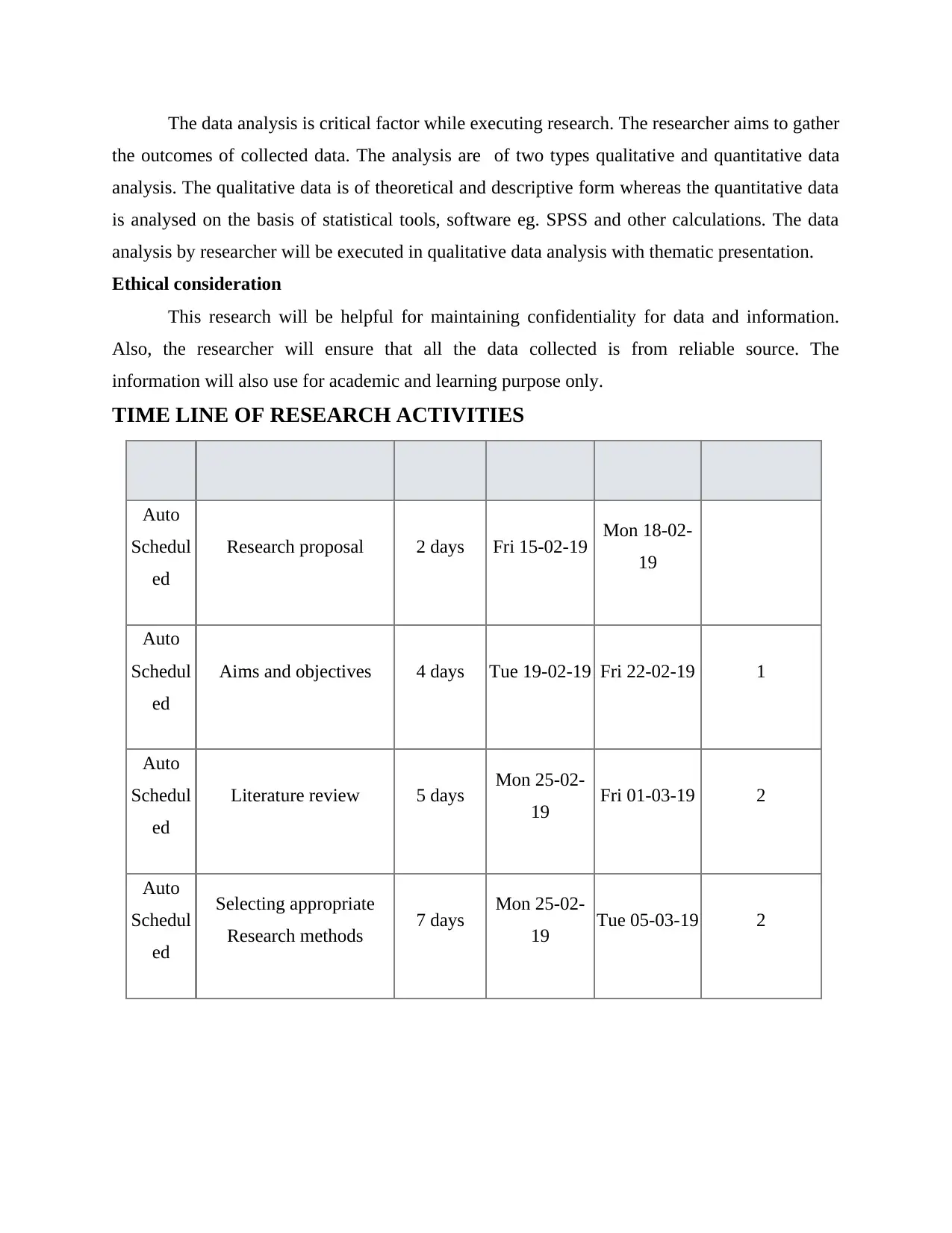
The data analysis is critical factor while executing research. The researcher aims to gather
the outcomes of collected data. The analysis are of two types qualitative and quantitative data
analysis. The qualitative data is of theoretical and descriptive form whereas the quantitative data
is analysed on the basis of statistical tools, software eg. SPSS and other calculations. The data
analysis by researcher will be executed in qualitative data analysis with thematic presentation.
Ethical consideration
This research will be helpful for maintaining confidentiality for data and information.
Also, the researcher will ensure that all the data collected is from reliable source. The
information will also use for academic and learning purpose only.
TIME LINE OF RESEARCH ACTIVITIES
Auto
Schedul
ed
Research proposal 2 days Fri 15-02-19 Mon 18-02-
19
Auto
Schedul
ed
Aims and objectives 4 days Tue 19-02-19 Fri 22-02-19 1
Auto
Schedul
ed
Literature review 5 days Mon 25-02-
19 Fri 01-03-19 2
Auto
Schedul
ed
Selecting appropriate
Research methods 7 days Mon 25-02-
19 Tue 05-03-19 2
the outcomes of collected data. The analysis are of two types qualitative and quantitative data
analysis. The qualitative data is of theoretical and descriptive form whereas the quantitative data
is analysed on the basis of statistical tools, software eg. SPSS and other calculations. The data
analysis by researcher will be executed in qualitative data analysis with thematic presentation.
Ethical consideration
This research will be helpful for maintaining confidentiality for data and information.
Also, the researcher will ensure that all the data collected is from reliable source. The
information will also use for academic and learning purpose only.
TIME LINE OF RESEARCH ACTIVITIES
Auto
Schedul
ed
Research proposal 2 days Fri 15-02-19 Mon 18-02-
19
Auto
Schedul
ed
Aims and objectives 4 days Tue 19-02-19 Fri 22-02-19 1
Auto
Schedul
ed
Literature review 5 days Mon 25-02-
19 Fri 01-03-19 2
Auto
Schedul
ed
Selecting appropriate
Research methods 7 days Mon 25-02-
19 Tue 05-03-19 2
Paraphrase This Document
Need a fresh take? Get an instant paraphrase of this document with our AI Paraphraser
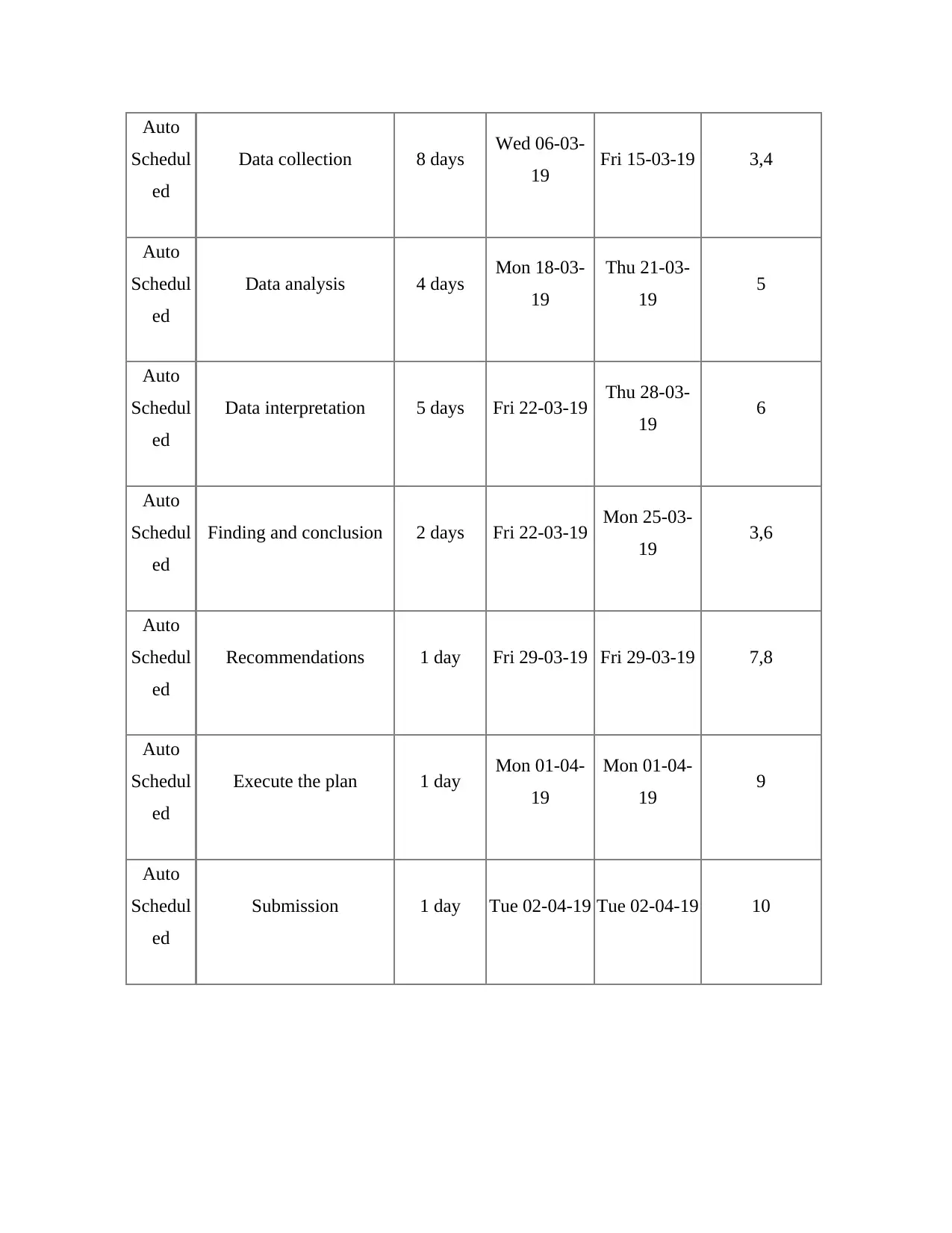
Auto
Schedul
ed
Data collection 8 days Wed 06-03-
19 Fri 15-03-19 3,4
Auto
Schedul
ed
Data analysis 4 days Mon 18-03-
19
Thu 21-03-
19 5
Auto
Schedul
ed
Data interpretation 5 days Fri 22-03-19 Thu 28-03-
19 6
Auto
Schedul
ed
Finding and conclusion 2 days Fri 22-03-19 Mon 25-03-
19 3,6
Auto
Schedul
ed
Recommendations 1 day Fri 29-03-19 Fri 29-03-19 7,8
Auto
Schedul
ed
Execute the plan 1 day Mon 01-04-
19
Mon 01-04-
19 9
Auto
Schedul
ed
Submission 1 day Tue 02-04-19 Tue 02-04-19 10
Schedul
ed
Data collection 8 days Wed 06-03-
19 Fri 15-03-19 3,4
Auto
Schedul
ed
Data analysis 4 days Mon 18-03-
19
Thu 21-03-
19 5
Auto
Schedul
ed
Data interpretation 5 days Fri 22-03-19 Thu 28-03-
19 6
Auto
Schedul
ed
Finding and conclusion 2 days Fri 22-03-19 Mon 25-03-
19 3,6
Auto
Schedul
ed
Recommendations 1 day Fri 29-03-19 Fri 29-03-19 7,8
Auto
Schedul
ed
Execute the plan 1 day Mon 01-04-
19
Mon 01-04-
19 9
Auto
Schedul
ed
Submission 1 day Tue 02-04-19 Tue 02-04-19 10

Part 2: Research Project
⊘ This is a preview!⊘
Do you want full access?
Subscribe today to unlock all pages.

Trusted by 1+ million students worldwide
1 out of 32
Related Documents
Your All-in-One AI-Powered Toolkit for Academic Success.
+13062052269
info@desklib.com
Available 24*7 on WhatsApp / Email
![[object Object]](/_next/static/media/star-bottom.7253800d.svg)
Unlock your academic potential
Copyright © 2020–2025 A2Z Services. All Rights Reserved. Developed and managed by ZUCOL.





